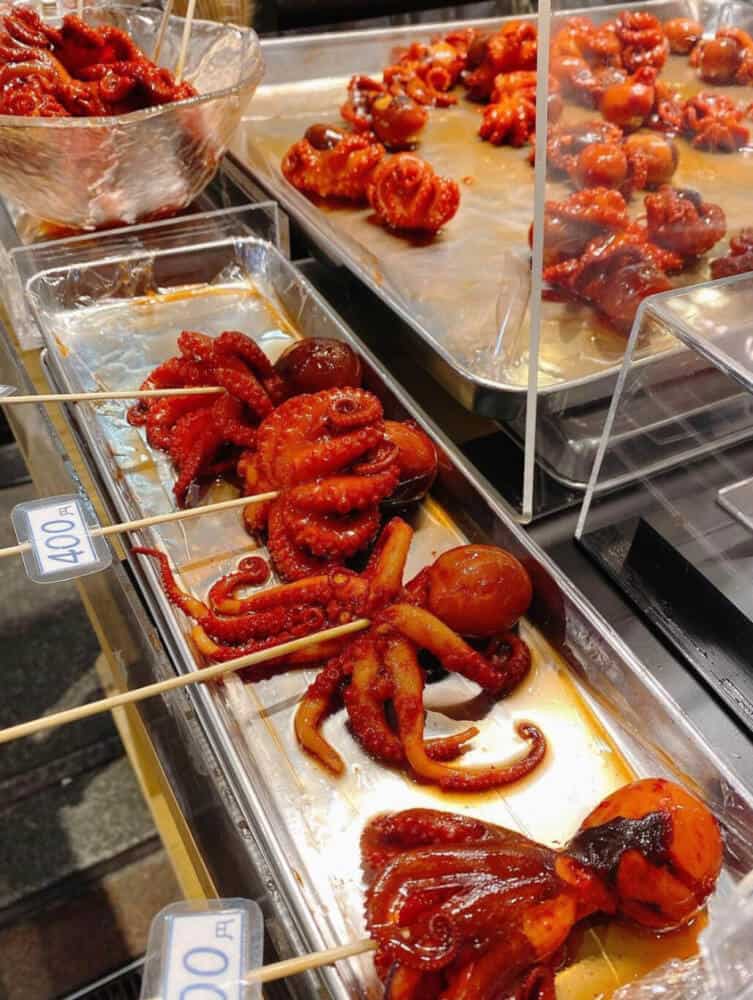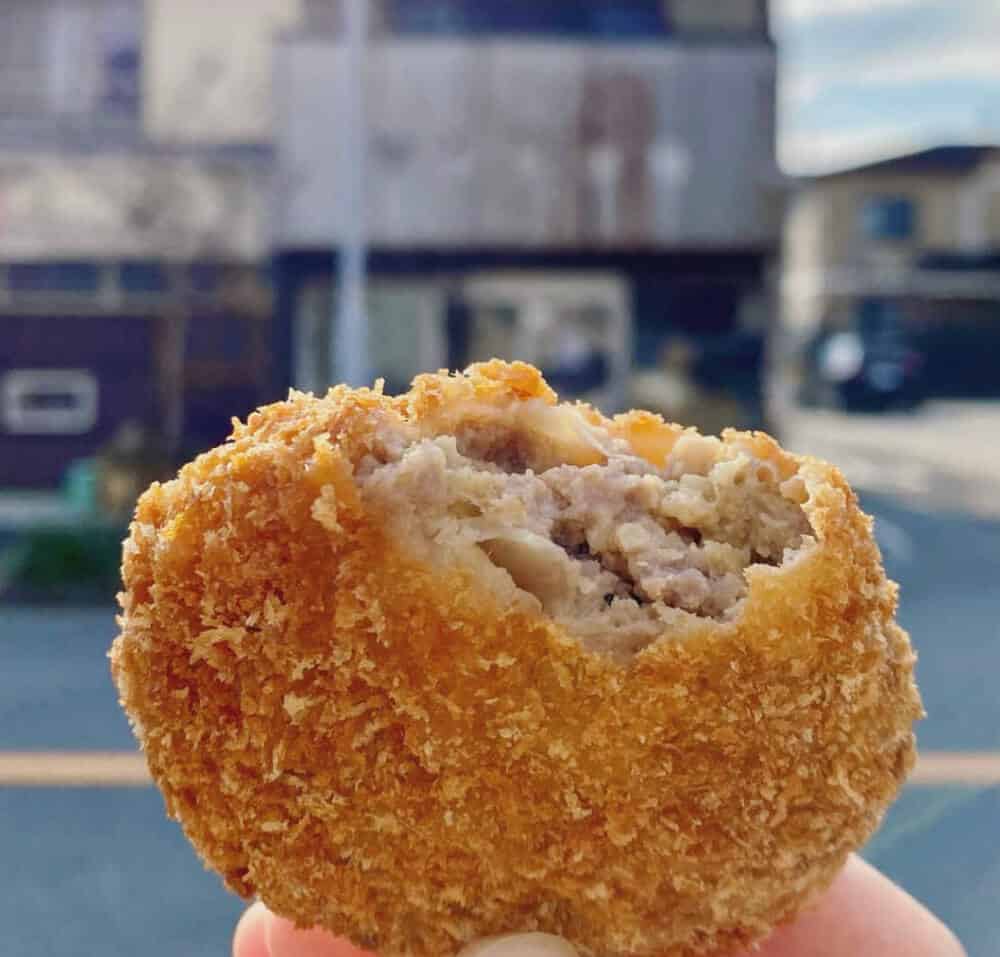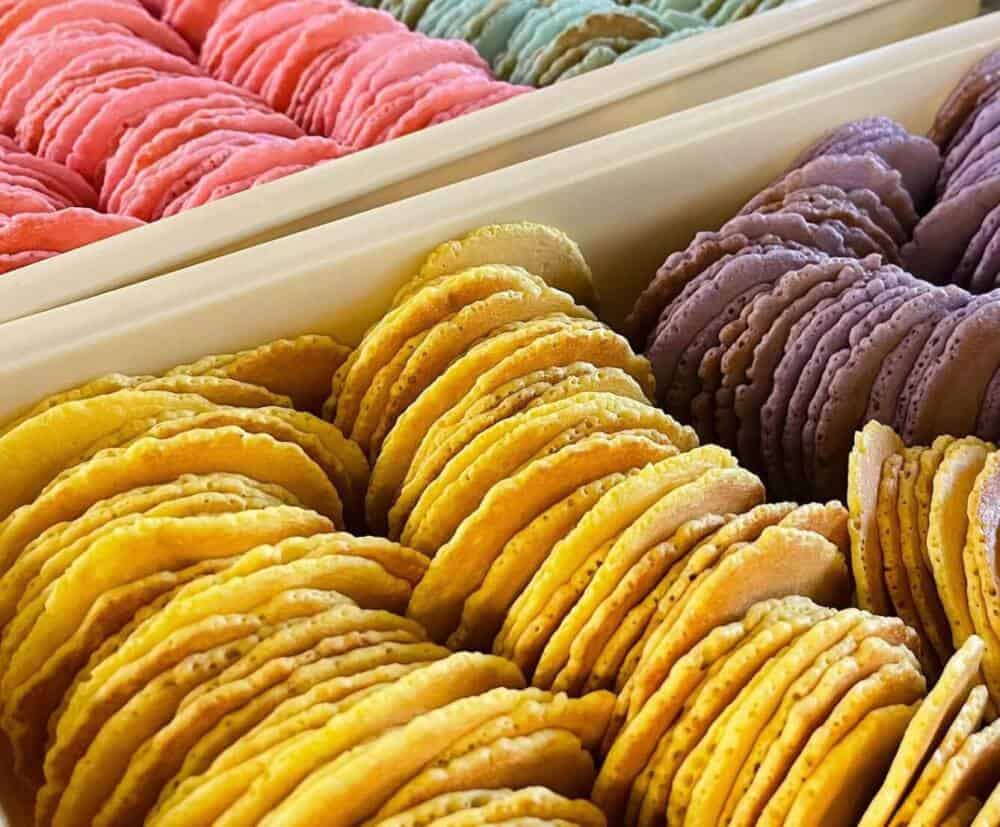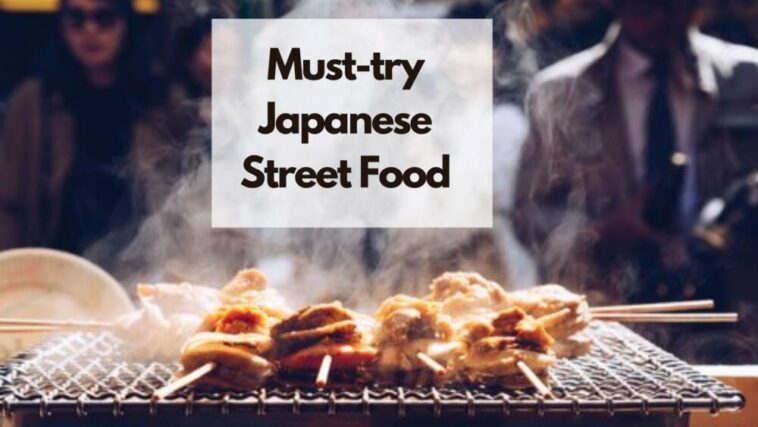If you’re visiting Japan, here are the must-try Japanese street food you simply cannot miss out on!
To those who think Japan is only famous for anime, top-quality electrical goods, and vehicles, then you’re wrong. Japan is renowned for its appetizing and unique food. The one Japanese food most of us are familiar with is sushi.
But today we’re going to introduce various and delicious Japanese street foods that not only look good to the eyes but also make your mouth drool.
Like most street foods in different countries, Japanese street foods are sold by street vendors on stalls called ‘Yattai’. They can be widely seen during Japanese festivals and they sell a great variety of delicious Japanese street food.

Shoutout: ByFood has some interesting proposals here. Do check them out.
Page Contents
Must-Try Japanese Street Food in JAPAN
Since the choices can be overwhelming we have made it convenient for you by preparing a list of Japanese street food you’d love to try.
Dango
Dango is an authentic Japanese street food that’s made out of rice flour, uruchi flour, and glutinous rice flour called ‘mochiko’. They are made into medium-sized balls filled with a sweet filling such as red bean paste. They are commonly served on a stick in numbers of three per stick.
They are sold on Japanese streets throughout the year but their flavors depend on each season. For instance, during the cherry blossom blooming season, the Dango is served in three colors like pink, white and green; the colors that represent the cherry blossom flowers.
There are numerous dango flavors available such as matcha and sesame and they are also made out of different types of flour like millet and toasted soy flour. You’ll also find dango topped with soy sauce and black sesame paste.
Dango is one of my favorite Japanese street food and it’s unlike any street food I’ve tried before. They are chewy, yummy, sweet, and also have a hint of nuttiness. Once you try dango you’ll keep wanting more of it.
- Related: Best Japanese Cookbooks
- Related: Reasons Why Japanese Eat Raw Fish
- Related: Best Japanese Food
- Related: Best Japanese Snacks
Takoyaki
Takoyaki is another favorite Japanese street food of mine that has a rich and succulent taste to it. They are also known as octopus balls since that’s their crucial filling. They are made in a special mold that has a round shape.
Takoyaki is made out of a wheat flour batter that’s filled with diced octopus, green onions, pickled ginger, and tempura scraps. While cooking the takoyaki balls are topped with Worcestershire sauce and mayonnaise.
Similar to dango, Takoyaki balls are served on a stick and sometimes on paper containers, and vendors would offer you a stick for ease of picking them up. Once you bite into the takoyaki balls you’ll be transported to a different world.
They are packed with flavors of chewy octopus pieces, spicy tempura and, they also have a sweet hint of pickled ginger. You can eat them by the stick and keep walking down the street to discover more delicious Japanese street food.
- Related: Eating Healthy in Japan
Yaki Tomorokoshi
If you want to go for something simple yet nutritious and tasty then Yaki Tomorokoshi is your go-to option. Yaki Tomorokoshi is corn on the cob but it has quite a distinct taste, unlike any corn in the cob you’ve ever had.
It has Japanese flavors infused on the corn since they are rubbed with miso, soy sauce, and topped with a blob of butter. The corn is grilled evenly on all sides and served on a stick for eating conveniently.
They taste fresh and amazing and are also priced cheaply. Make sure to give it a try when you travel to Japan.
Yakitori
This is an exotic choice of Japanese street food you’ll find street vendors selling. To incorporate protein in your street food shopping spree, this is what you should be getting.
Yakitori is Japanese for grilled bird and it’s usually chicken that’s skewered. The skewers are generally either metal or bamboo sticks and the meat is grilled over charcoal. Street vendors generally use portable charcoal grills since they’re easier to cook with.
The chicken pieces are usually seasoned with tare sauce, salt, and pepper either while cooking or after cooking.
Yakitori is topped with soy sauce and sesame seeds to give them extra flavor. You’ll also find other choices of meat like beef, pork, sparrow and seafood, etc. Hence make sure to ask the vendor before trying them out.
Yakisoba
Yakisoba is a noodle dish that’s stir-fried in a wok with vegetables, meat, and Japanese condiments like tangy soy sauce. If you’re into extremely spicy food then you’ll love Yakisoba noodles.
They have an appearance like ramen but are served without a broth. Yakisoba means fried noodles and the noodles are made out of wheat flour. To make them flavorful Japanese street vendors add special tangy stir fry sauce and vegetables like green onions, and carrots.
You can also ask for your favorite source of protein like chicken, shrimp, and beef, etc.
Yakisoba noodles are usually served in paper boxes with chopsticks. They are topped with an egg, sesame seeds, and ginger. It’s a great view watching the vendor make the noodles in the wok pan and once done you’re served with a colorful and delicious meal.
Okonomiyaki
This is a staple Japanese street food that has several variations to it. It’s a savory Japanese pancake made using wheat flour batter and some ingredients like cabbage, meat, and seafood are either mixed in the batter or served on top.
However, the ingredients used in the batter vary depending on the street food vendors. The pancake batter is poured on a hot metal griddle and flipped over when it’s cooked enough.
It’s then topped with special condiments, sauces, seaweed flakes, pickled ginger, and bonito flakes. One pair of okonomiyaki and you’ll be as full as ever. It has a mixture of savory, spicy and tangy flavors that’ll play around in your mouth when you bite into it. These savory pancakes are definitely worth the try.
Taiyaki
It’d be nice to have a yummy and warm desert after having to eat filling spicy food. That’s Taiyaki for you, a fish-shaped waffle filled with sweet fillings like custard, chocolate, and red bean paste. Of course, you can ask for your choice of filling.
They are made in a fish-shaped mold and prepared right in front of your eyes. They not only look cute but also have a yummy taste that’ll linger in your mouth.
Bite into the warm taiyaki and you’ll taste the gooey filling bursting in your mouth. They are satisfying to eat especially after a full meal during the fall season.
Kakigori
Kakigori is Japanese shaved ice served with colorful and flavorful toppings. This dessert is way different from the regular shaved ice. Kakigori comes in a variety of flavors such as matcha, lemon, grape, strawberry, and cherry.
You can see vendors shaving the block of ice usually by hand and then the shaved ice is placed in a cup and shaped into a cone. You can ask for your favorite toppings on kakigori and the vendors also add sweet condensed milk for extra sweetness.
The texture of the ice in kakigori is like soft snow unlike the hard shaved ice we get in shops. Hence, the shaved ice in kakigori is referred to as Angel Snow. Get your cup of icy kakigori and enjoy the summer evening.
Candied Fruits
We know desserts can be unhealthy due to the amount of sugar incorporated in them. But if you want a light yet delicious dessert then candied fruits it is. Candied fruits are found in most countries sold by street vendors but Japanese candied fruits come in variations.
There is Anzu Ame which is candied apricot that is cut into bite-size pieces, pickled with vinegar, pricked with a wooden stick, and then dipped into a hot sugar syrup. To prevent the sugar coating from melting street vendors immediately put the candied apricot into iced wold water.
This forms a very hard sugar coating over the apricot and you need strong teeth to bite into. The same process is applied to other fruits like apples and strawberries. Candied fruits are usually available during Japanese festivals.
Mochi
Mochi is one of my favorite Japanese desserts of all time. It’s made out of glutinous pounded rice, water, cornstarch, and a little bit of sugar. It’s initially formed into a paste and then formed into any desired shape.
Street vendors mostly form the dough into medium-sized balls and they are filled with varieties of fillings such as red bean, sesame paste, and ice cream.
Mochi typically comes in three colors like white, light green, and pink, and they’re rolled over potato flour to prevent them from sticking. They’re steamed with the fillings in them and this gives mochi a chewy outer texture. Mochi is a specialty during the Japanese New Year and they’re eaten throughout the year.
Tako Tamago
Tako Tamago is a popular Japanese street food that consists of grilled octopus (tako) served on a skewer, often accompanied by a quail egg (tamago).
It is a delightful and tasty treat that can be found at festivals, food stalls, and street markets throughout Japan.
The name “Tako Tamago” directly translates to “octopus egg,” referring to the combination of octopus and quail egg on a skewer.

The dish is typically made by grilling or boiling octopus until it becomes tender and then skewering it along with a boiled or steamed quail egg.
The skewered tako tamago is often brushed with a savory sauce, such as a soy-based glaze, for added flavor.
The octopus used in Tako Tamago is usually bite-sized, with each piece offering a tender and slightly chewy texture.
Octopus is a beloved ingredient in Japanese cuisine, and its mild flavor pairs well with the rich and creamy taste of the quail egg.
The quail egg, known for its smaller size compared to a chicken egg, is often boiled until the yolk is still soft, creating a delightful contrast with the tender octopus.
Tako Tamago is not only enjoyed for its taste but also for its visual appeal. The skewers are often presented in an attractive manner, with the alternating octopus and quail eggs creating an appealing pattern.
The combination of flavors and textures, along with the convenient and portable nature of the skewers, makes Tako Tamago a favorite choice for people on the go.
When visiting Japan or exploring Japanese cuisine, keep an eye out for Tako Tamago at street food stalls or festivals. It is a delicious and convenient snack that showcases the country’s culinary creativity and love for seafood.
Kushiten
Kushiten is a type of Japanese street food that consists of skewered fish cakes. The fish cakes are made with surimi, which is a type of white fish paste that is often used in Japanese cuisine.
The surimi is mixed with other ingredients, such as egg, potato starch, and salt, and then shaped into small patties.
The patties are then skewered and either steamed, grilled, or deep-fried.
Kushiten is a popular street food in Japan, and it is often served at festivals and other events. It is also a common dish in izakaya, which are Japanese pubs.
Kushiten is typically served with a dipping sauce, such as soy sauce or mayonnaise.
Here are some of the most common types of kushiten:
- Tempura kushiten: These are fish cakes that have been deep-fried. They are typically crispy on the outside and soft on the inside.
- Grilled kushiten: These are fish cakes that have been grilled. They have a slightly smoky flavor and are a bit chewier than tempura kushiten.
- Steamed kushiten: These are fish cakes that have been steamed. They are the lightest and most delicate type of kushiten.
Kushiten is a delicious and versatile street food that can be enjoyed on its own or as part of a larger meal.
It is a great way to try different types of Japanese fish cakes and to experience the flavors of Japanese street food culture.
Korokke
Korokke, also known as croquettes, is a popular Japanese dish that has its origins in Western cuisine.
It is a fried food made by shaping a mixture of ingredients into a patty or cylinder, coating it in breadcrumbs, and deep-frying until golden and crispy.
The basic ingredients for korokke typically include mashed potatoes, ground meat (such as beef, pork, or chicken), or a combination of both.
However, there are various variations and fillings that can be used, such as seafood, vegetables, cheese, or curry.

The mixture is seasoned with ingredients like salt, pepper, and sometimes spices or herbs, depending on the desired flavor profile.
To make korokke, the filling mixture is formed into flat or cylindrical shapes, then coated in flour, dipped in beaten egg, and finally coated with breadcrumbs.
This three-step coating process helps to achieve a crispy outer layer when fried. Once coated, the korokke is deep-fried until golden and crispy on the outside, while the interior becomes soft and flavorful.
Korokke is commonly served as a snack, side dish, or part of a bento lunch box. It is also enjoyed as street food at festivals or as a popular item in convenience stores.
Some people like to eat korokke with a side of tonkatsu sauce, a tangy and sweet condiment similar to Worcestershire sauce, or with a sprinkle of salt.
The dish has become an integral part of Japanese cuisine, with regional variations and unique fillings.
In addition to the classic potato and meat fillings, you can find korokke filled with ingredients like corn, shrimp, crab, curry, or even cheese. Each variation offers its own distinct flavor and texture, making korokke a versatile and widely loved dish in Japan.
Whether enjoyed on its own or as part of a meal, korokke is a delicious and comforting treat that combines a crispy exterior with a flavorful and often savory filling.
Senbei
Senbei is a traditional Japanese snack that consists of a type of rice cracker. It is a popular and beloved treat enjoyed by people of all ages in Japan. Senbei has a long history and comes in various shapes, sizes, and flavors.
The main ingredient in senbei is rice, specifically glutinous or non-glutinous rice, which is cooked and then flattened into thin discs or squares.

The rice crackers are typically baked or grilled, which gives them a crispy texture. Traditional methods involve baking them over an open flame or using specialized grills called “senbei-ki.”
Senbei can be categorized into different types based on their preparation methods and flavors.
Here are some common variations:
- Shoyu Senbei: These are soy sauce-flavored senbei, which are often savory and slightly salty. The rice crackers are usually brushed with a soy sauce glaze before being baked or grilled.
- Nori Senbei: Nori, or seaweed, is a popular flavoring for senbei. Thin sheets of nori are often wrapped around the rice cracker before it is baked or grilled, adding a delightful umami taste.
- Ara-Age Senbei: Ara-age senbei are deep-fried rather than baked or grilled. They have a lighter, airier texture and are typically seasoned with salt or other flavors.
- Mame Senbei: Mame senbei are small and bite-sized rice crackers that are mixed with peanuts or other legumes, giving them a nutty flavor and crunch.
- Sweet Senbei: While senbei are commonly savory, there are also sweet variations available. These sweet senbei are often made with sugar or honey, and they may be flavored with ingredients like black sesame, matcha (green tea), or kinako (roasted soybean flour).
Senbei can be found in various settings, including specialty senbei shops, supermarkets, and even at festivals. They are often packaged in small individual packs, making them convenient for snacking on the go or for sharing with others.
In addition to their delicious taste, senbei also holds cultural significance in Japan. They are often served to guests during tea ceremonies or offered as omiyage (souvenirs) when visiting someone’s home.
Whether you prefer the savory or sweet varieties, senbei offers a satisfying and crunchy snack experience that showcases the simplicity and versatility of rice in Japanese cuisine.
Onigiri
onigiri is a Japanese street food. It is a type of rice ball that is typically filled with a savory filling, such as umeboshi (pickled plum), tuna salad, or salmon roe.
Onigiri are often wrapped in nori (dried seaweed), and they can be found at convenience stores, markets, and street stalls all over Japan.
Onigiri are a convenient and portable food, making them a popular choice for people on the go.
They are also a good source of energy, making them a popular choice for hikers, cyclists, and other outdoor enthusiasts.
Here are some of the most popular types of onigiri:
- Tuna salad onigiri: This is a classic type of onigiri that is filled with tuna salad. The tuna salad is typically made with tuna, mayonnaise, and other ingredients, such as celery, onion, and pickles.
- Salmon roe onigiri: This is a type of onigiri that is filled with salmon roe. Salmon roe is a type of fish eggs that have a salty, briny flavor.
- Umeboshi onigiri: This is a type of onigiri that is filled with umeboshi (pickled plum). Umeboshi have a sour, salty flavor that some people find to be very refreshing.
Onigiri are a delicious and versatile street food that can be enjoyed on their own or as part of a larger meal.
They are a great way to try different flavors of Japanese cuisine and to experience the flavors of Japanese street food culture.
Ikayaki
Ikayaki is a Japanese dish of grilled squid. The word “ika” means “squid” in Japanese, and “yaki” means “grilled.”
Ikayaki is a popular street food in Japan, and it is often served at festivals and other events. It is also a common dish in izakaya, which are Japanese pubs.
Ikayaki can be made with whole squid, squid rings, or squid tentacles. The squid is typically grilled over a charcoal fire, and it is brushed with a soy sauce-based glaze.
Ikayaki is often served with a dipping sauce, such as soy sauce or mayonnaise.
Here are some of the most popular types of ikayaki:
- Whole squid ikayaki: This is the most traditional type of ikayaki. The squid is grilled whole, and it is often served with the tentacles attached.
- Squid ring ikayaki: This is a popular type of ikayaki that is made with squid rings. The squid rings are grilled until they are crispy and tender.
- Squid tentacle ikayaki: This is a popular type of ikayaki that is made with squid tentacles. The squid tentacles are grilled until they are crispy and chewy.
Ikayaki is a delicious and versatile dish that can be enjoyed on its own or as part of a larger meal. It is a great way to try different flavors of Japanese cuisine and to experience the flavors of Japanese street food culture.
Japanese Street Food: FAQs
What is the most popular Japanese street food?
The most popular Japanese street foods are Dango, Takoyaki, Yaki Tomorokoshi, Yakitori, Yakisoba, Okonomiyaki, Taiyaki, Kakigori, Candied Fruits and Mochi. Most Japanese street foods are sold on sticks that help people to eat while walking in busy streets.
Where is the best street foods in Japan?
Street foods are widely available in all parts of Japan. But some places stand out from others and provide exotic and delicious street food. Some of the places that provide the best street foods in Japan are Fukuoka, Nakamise Street, Hokkaido, Tokyo, and Osaka.
What is the Japanese food on a stick?
There are quite a variety of foods that are sold on a stick in Japan. Vendors usually make bite-sized food and skewer them to make it convenient for street shoppers to eat while walking. Some of the Japanese food on a stick are Dango, Takoyaki, Yakitori. Even candied fruits are sold on a stick in Japan.
What is Tokoyami food?
Takoyaki is a popular Japanese street food that’s made out of batter filled with diced octopus, green onion, pickled ginger, and tempura. They are usually sold on sticks and are topped with sauces like ketchup, mayonnaise, and soy sauce.
What is Yakitori in Japanese?
Yakitori is Japanese for grilled chicken. It’s a popular Japanese street food that’s sold in Japan. It’s made out of bite-sized grilled chicken served on a skewer and topped with soy sauce and sesame seeds.
Also Read





